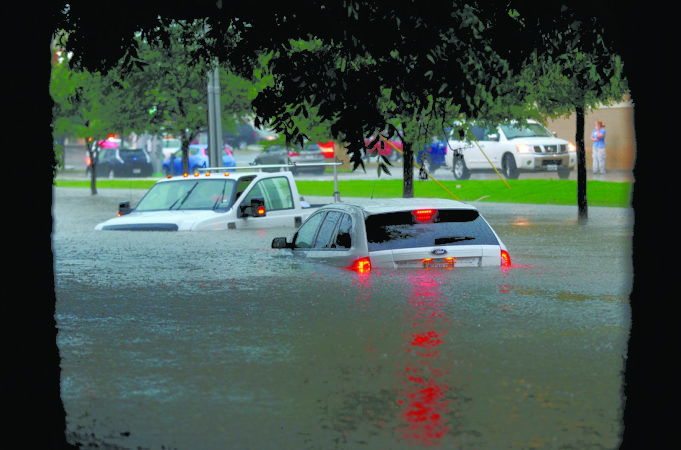Pocket parks, retention ponds, and underground floodwater containers are just three of the solutions being utilized by Fort Worth to mitigate the problem with street and home flooding in Arlington Heights after heavy rains, but none of them are permanent fixes to the long-term problem facing residents there. The real solution, according to city staffers, is tearing up the streets and replacing old storm-water pipes with much larger ones. It’s a simple solution with one drawback: It would cost the city between $50 and $80 million to do it, and the city just doesn’t have the cash lying around to pay for that.
Greg Simmons, assistant director for Fort Worth’s Department of Transportation and Public Works, and the point man on flood management, told the Fort Worth Weekly that “the pipe system that was installed 80-plus years ago is not large enough to keep rain runoff underground” all the way to the Trinity River.
The flooding Simmons is talking about occurs in three watershed areas in Arlington Heights, with the most severe flooding hitting the Central AH watershed, which includes Western, Ashland, and Carleton avenues. Residents say that it’s hard for non-residents to imagine what actually happens when the occasional storm drops several inches of rain in an hour. Dave Herman, who lives on Western, said, “It just roars through. We’ve had our cars flooded three or four times over the last 21 years.”
Herman said the flash floods have never gone into his house but that they have flooded the pier and beam beneath it. Neighbors of his have had their houses flooded and have found themselves “replacing carpets and drywall after each flood.”
At its worst, said several people from the area, the floods simply lift and carry cars and even pickup trucks down the street.
“When it’s bad you just better get out of the way,” said Jim Vreeland, who lives on Carleton.
He believes the flooding comes from the watershed by Camp Bowie Boulevard and Hulen Street, and “when you get one of those really hard rains, well, the pipes can’t handle it, and then it’s flood time.”
Vreeland admits that the city has been working hard to mitigate the flooding over the past several years. And he’s right. A retention pond was built at Hulen and Bryce Avenue recently, and several additional floodwater inlets and underground water retention containers were put in place on Western and Ashland avenues.
“I think the water used to get up higher years ago,” Vreeland said, and “while some think these things won’t really help, I’m not convinced that they won’t.”
The jury is still out in Vreeland’s opinion, because the last big flood occurred in June, before all of the improvements were finished.
John Morris, a board member of the Arlington Heights Neighborhood Association, agrees that the city improvements are a help, but he said that “at some point the city is going to have to come to a long-term, permanent solution.”
The solution, as everyone is aware, would be to tear up the streets in the flood areas and put in large storm-water drainage pipes that would carry the floodwater to the Trinity. But, as Simmons noted, the cost makes that unfeasible.
“You know,” said one resident who did not want her name used, “the city has funds for their Trinity [River] Vision project, and they have funds for their bridge to nowhere, but they don’t have money for this very important infrastructure issue. I don’t buy that.”
Brenda Helmer, president of Arlington Heights’ neighborhood association, says that while the temporary solutions are good, the city will eventually have to put in new storm pipe because of the continual development in the area, in which water-absorbing earth is replaced with impervious concrete. “Essentially,” she said, “the city has allowed over-building on an under-served community.”
One of the solutions that came up in 2011 and has recently been brought up again is the idea of simply buying out the houses that flood. Monies from the Federal Emergency Management Agency could be used toward the purchase of three-quarters of the price, with the city anteing up the remaining 25 percent. Those lots would then be stripped of impervious driveways and such, which might allow the rainwater to be absorbed before forming a flood.
There are several problems with that, Helmer said.
“If you use FEMA money to buy a home, you can never rebuild on that space again,” she said. “So you would have these spaces between homes that might sound like a good idea but bring their own problems. Who would maintain them? Who would pay for that maintenance? How would the property taxes lost on those properties be made up?”
Last Tuesday, the Fort Worth City Council took up the matter of the flooding in Arlington Heights. At a pre-council meeting, Simmons outlined the flood-mitigation options. While residents hoped there would be new information, what was discussed was simply a reiteration of what’s already on the table: FEMA-purchased homes, better flood warnings, and unaffordable storm pipes. At the actual City Council meeting later the same evening, councilmembers decided to look into applying for FEMA grants for the purchase of flood-plagued homes in early 2017.
One proposal that’s been bandied about suggests that flooding could be curtailed if somewhere between 22 and 40 homes were purchased and torn down. Morris noted that the homes in the area sell for as much as $350,000, so tearing down 20 or 40 of them would leave a big hole in the property tax revenue.
“You just can’t afford to take that much off the tax rolls,” he said. “So the rest of us would see our taxes going up, and then with no money dedicated to keeping up those empty lots — which would be called green belts or pocket parks — they’d eventually become eyesores, which will drop our property values.”
Morris, who said tearing down the houses would make the neighborhood look like a set of teeth with several missing, said the only reason the city is talking about tearing down flood-prone houses is because it’s “the cheapest alternative” the city has.
“What we really want,” Helmer said, “is to have the city fix the problem upstream. You can’t just allow people to overbuild continually without having a problem in the lower areas.”
Dave Herman says that he understands that people who have their homes flooded once or twice a year would love to be bought out but that he doesn’t like that solution at all.
“Personally,” he said, “I don’t want a lot of empty lots around here.”
Simmons insists that the solution isn’t complicated: “It’s simply a question of bigger storm-water pipes. The problem is where are you going to find the $50 to $80 million?”













The buyouts are part of the flood mitigating process the qualified engineers at the city and contracted firms have recommended. The solutions have been to collect as much water through non-invasive processes like underground street channels that have been constructed. The next phase is collecting as much surface water that will not fit in underground channels with the green spaces that flow where the original creek bed was in Arlington Heights. It’s part of a larger plan to reduce buyout impacts in the neighborhood. Some sacrifices have to be made and it is voluntary. Once the spaces are created and managed by the city it will be an enhancement to the neighborhood.